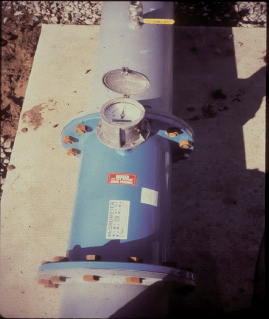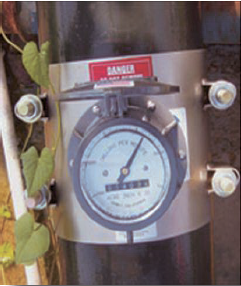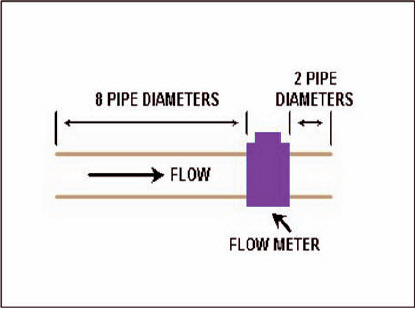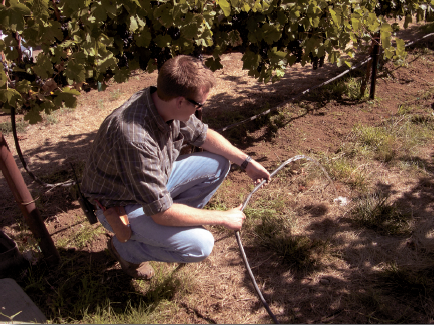Introduction
Thank you for reading Part III of this three-part series on water management. In Part I we discussed the importance of having a written water management plan, the advantages of Regulated Deficit Irrigation (RDI), monitoring water quality and soil water-holding capacity, and vine water status as a measure of water stress. In Part II we focused on irrigation scheduling, pump energy efficiency, and distribution uniformity.
This Coffee Shop article is an expert from the Lodi Winegrower’s Workbook (Chapter 5: Water Management). The Workbook is a comprehensive, practical, and user-friendly guide to farming winegrapes. The Lodi Winegrape Commission has handed out hundreds of copies over the years, and growers continue to pick more up at our monthly educational meetings. Workbooks are free to all Crush District 11 (Lodi) growers, and can be ordered from the Commission: (209) 367-4727. Click HERE to learn more.
Flow meters
Irrigation flow meters work like the speedometer in your car, except, instead of measuring vehicle speed in miles per hour, they measure the current pumping rates usually in gallons per minute. Flow meters are also like your cars odometer in that they track the total gallons or acre-inches pumped.
Water meters are an integral part of an accurate irrigation scheduling program. They can be used to confirm the scheduled amount of water was delivered to the vineyard. The gallons per minute readout can help set diesel pumps for a specific flow rate and can help indicate the existence of leaks or emitter clogging.
Micro-irrigation maintenance
Micro-irrigation systems may require a significant amount of maintenance to continue operating at maximum efficiency. Routine maintenance can include checking for leaks, backflushing filters, periodically flushing lines, chlorinating, acidifying, and cleaning or replacing clogged emitters.
Flushing the system. Filters should be backflushed periodically to clear any collected particulate or organic matter. Clogged filters can reduce pressure to the system, lowering the water application rate. Backflushing can be done either manually or automatically.
Mainlines, submains, and particularly lateral lines should be flushed periodically to clear away any accumulated particulates. Mainlines and submains are flushed by opening the flush valves built into the system for that purpose. When the system is designed, the flush valves should be sized large enough to allow the water velocity to move particulates out of the system.
Polyethylene lateral lines are flushed by opening the lines and allowing them to clear. This measure is essential since the filters trap only the large contaminants entering the system, allowing the lateral lines to collect material that may eventually clog the emitters. Flushing clears the system of many contaminants.
Chlorinating. Water with a high organic load (algae, moss, and bacterial slimes) should undergo chlorination with chlorine gas, sodium hypochlorite, or calcium hypochlorite. Whether to chlorinate continuously (1 to 2 ppm free chlorine at the end of lateral line) or periodically (approximately 10 ppm free chlorine at the lateral end) depends on the severity of the clogging. Continuous chlorination is usually necessary when the clogging potential is severe. Surface water is more likely than groundwater to cause organic clogging. Well water pumped into and stored in a pond or reservoir should be considered a surface water source.
Acidifying. Acidification may be required for irrigation water that has a tendency to form chemical precipitates such as calcium carbonate (lime) or iron. Groundwater sources are most susceptible to chemical precipitation. Lowering the pH of the water to 7 or below is usually sufficient to minimize calcium carbonate or lime precipitate problems. Acids that can be added to the irrigation water include sulfuric, hydrochloric or murietic acid, and phosphoric acid. A urea-sulfuric acid fertilizer is frequently used and is safer to handle. Acidification has the added benefit of increasing the efficacy of chlorine additions, but the acid and chlorine sources should never be mixed together since hazardous chlorine gas will be formed.
Cleaning or replacing emitters. Emitters used for permanent crops may have to be cleaned or replaced because of clogging. The laterals and emitters should be inspected routinely to identify drip emitters that are completely clogged, although this will probably not identify emitters in which the flow has been only reduced. Partially clogged emitters can be located by collecting water from the emitters to determine their discharge rate. The first step in cleaning emitters is determining what has caused the clogging. Material caught when the laterals are flushed can be examined. If organic matter is found, a high level of chlorine (approximately 50 ppm) can be injected into the line for 2 hours or more and then allowed to sit for about 24 hours. The lines should then be thoroughly flushed. If chemical precipitation appears to be the cause, then acid can be injected for 2 hours or more to lower the pH to approximately 5. The acid should be allowed to sit in the line for 24 hours and then flushed. If injecting chlorine or acid does not clear the clogging, the faulty emitters may have to be replaced, in which case it is usually wise to leave a clogged emitter in the line and simply install a new emitter nearby. Although some brands of drip emitters can be disassembled and cleaned, nearly all are permanently sealed. In the case of pressure compensating emitters, contact the manufacturer to determine the minimum pH allowable. The flexible orifices in some pressure compensating emitters are damaged by water with a pH of 4 or below.
Inspecting or replacing other parts. Other maintenance tasks to be carried out on a less frequent basis include inspecting the filter media, pressure-regulating valves, flush valves at the end of laterals, and replacing pressure gauges. A sand media filter tends to cake together over time and as a result may fail to provide good filtration. Frequent backflushing may be symptomatic of such a problem. The sand media should be replaced if this occurs. When the old media is removed, the underdrain system should be inspected. Even if the sand media appears to be in good condition, adding media periodically may be required, since some of the sand is invariably lost during the backflush cycle.
The adjustable pressure-regulating valves, set at installation, should be inspected and adjusted periodically to see that the correct operating pressure is maintained. Preset pressure regulators should be inspected to ensure that they are operating properly. Foreign material in the line may jam the adjustment mechanism and inhibit operation.
Pressure gauges tend to wear out eventually and should be replaced if their accuracy is in question. Liquid filled pressure gauges, which are slightly more expensive than the standard gauges, may be a good replacement choice. The gauges must be scaled to operate in a pressure range appropriate for the system. Micro-irrigation systems should be inspected regularly for leaks, a task that can be performed at the same time as checking for clogged emitters. Leaks can occur in hardware (compression fittings, end closures, emitter barbs, microsprinklers, and hose adapters) or when the aboveground polyethylene tubing is damaged by farm equipment, harvest activity, or animals.
Fertigation
What is fertigation? Fertigation is the common term for injecting fertilizers or soil amendments through the irrigation system. Appling these materials through a micro-irrigation system has many benefits:
- Makes fertilizer distribution relatively uniform
- Allows flexibility in timing fertilizer application
- Reduces labor required for application in relation to other methods
- Allows for reduced fertilizer application rates
- Lower overall costs
Water source contamination can occur if:
- The irrigation water pumping plant shuts down while the injecting equipment continues to operate, causing contamination of the water source or unnecessary amounts of fertilizer to be injected into the irrigation system.
- The injection equipment stops while the irrigation system continues to operate, causing the irrigation water to flow into the chemical supply tank to overflow.
Backflow prevention devices which include check valves and vacuum breakers are required on well heads to prevent water source contamination. If the injection pump is electrically driven, an interlock should be installed so that the injection pump will stop if the irrigation pump shuts down. To keep water from flowing backward into the chemical tank, a check valve or normally closed solenoid valve (with pump interlock) should be installed in the injection line. A schematic of a positive displacement pump injection system is presented in Figure 5.4 as an example of proper system setup.






